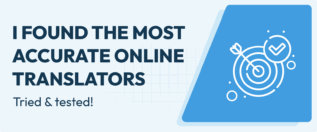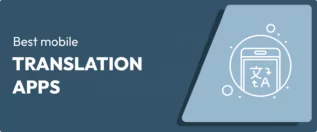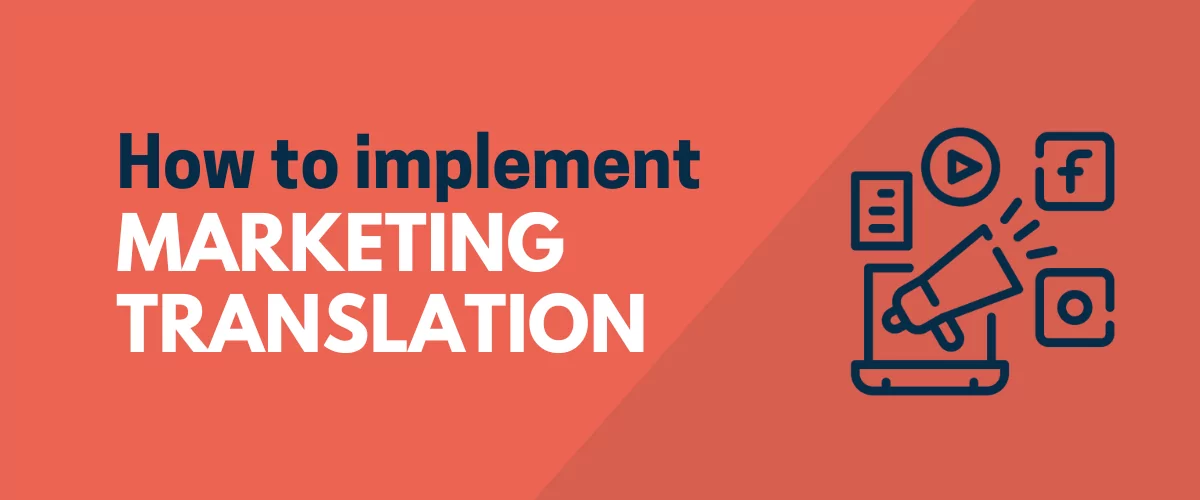
In this post
Marketing translation is one of the most effective tools to drive international growth for your business.
It involves translating all marketing content into one or more languages and the process typically goes far beyond simple linguistic translations.
In this article, we will dive deeper into what marketing translations involve, the many benefits and challenges of the translation process, and the steps you need to take to implement marketing translations in your business.
Let’s get started.
What is Marketing Translation?
Simply put, marketing translation refers to the translation of all marketing content into one or more languages.
The areas of marketing that warrant translation include business websites, social media posts, product descriptions, email campaigns, press releases, brochures, offline advertisements, and other promotional materials.
The goal of implementing marketing translation is to effectively convey the intended marketing message to diverse audiences across various markets and drive your business to success.
It’s important to understand that marketing translation is not as simple as translating content into different languages.
It requires an expert understanding of cultural nuances, linguistic subtleties, and market dynamics to ensure that the business avoids misinterpretation and cultural insensitivity which could ruin its brand image and squash any dream of expansion and global success.
As you can imagine, implementing marketing translation is a long and complicated process.
In this article, we will show you how to successfully implement marketing translation but first let’s take a quick dive into the many benefits and challenges of implementing marketing translation.
Benefits of Marketing Translations

The common benefits of implementing marketing translation for your business are:
Better Reach: Translating all your marketing content allows your business to communicate with potential customers in their native languages. Such multilingual marketing efforts are likely to build trust and increase engagement levels with your product and services.
Increased Brand Awareness: More people engaging with your business heightens your brand awareness. This heightened awareness attracts new customers but also reinforces loyalty among existing ones. It allows businesses to differentiate themselves in competitive markets, and solidify their reputation as a trusted and inclusive brand.
Increased Revenue: Better reach and heightened brand awareness could easily translate to better revenue collection. The more people encounter your marketing content tailored to resonate with different cultural backgrounds, the more they feel understood and valued and are inclined to purchase your product or service.
Industry Leader: By leveraging marketing translation businesses can create a strong brand presence, foster customer loyalty, and differentiate themselves in competitive markets. As a result of such consistent effort, businesses can establish themselves as the go-to authority in their respective fields, driving long-term success and sustainability.
Business Longevity: By catering to different markets businesses can reduce dependency on a single market, and ensure that businesses remain afloat and thriving during economic downturns or shifts in consumer preferences. Marketing translation makes the business resilient and ensures longevity in an ever-changing economic landscape.
Challenges of Marketing Translations
Next, let’s take a look at the challenges you are likely to face when implementing marketing translations:
Cultural Nuances: Messages that resonate well in one language may not have the same impact when directly translated into another language. Understanding cultural subtleties, idiomatic expressions, beliefs, and values is crucial but also a lot of work. Moreover, failure to address cultural nuances can lead to misinterpretations, potentially damaging brand reputation, hindering the effectiveness of marketing campaigns, and even preventing future success.
Language Complexity: Some languages have unique grammatical structures, tones, or writing systems that may not directly translate into other languages. Finding the right balance between linguistic accuracy and readability requires skilled linguists and cultural experts which can be a time-consuming and expensive affair.
Brand Consistency: Maintaining brand voice, tone, and messaging consistency across different languages while ensuring that the essence of the brand is not lost in translation can be difficult. Any discrepancies in translation can lead to fragmented brand perception across diverse markets.
Legal & Regulatory Compliance: Different consumer markets have different laws and guidelines on marketing, advertisements, collection, and use of personal information among other things. Translating marketing content while adhering to these regulations requires meticulous attention to detail and a deep understanding of local legal frameworks. Failure to comply with legal requirements can result in fines, reputational damage, or even legal consequences for businesses.
Time & Resources: Coordinating multiple projects across different languages, ensuring quality translations, and meeting tight deadlines require hiring skilled professionals, access to resources, and efficient project management, and collaboration techniques. Catering to all these requires time, effort, and funds.
Now that you have some idea of the benefits and challenges of marketing translations, let’s dive into the steps of implementing it for your business.
How to Implement Marketing Translations For Your Business
To implement marketing translations for your business, you need to carry out the following steps:
1. Assess Market Needs

One of the first things you’d need to do is determine the regions or countries where your products or services can be sold. This can be done by
- Looking at competitors who are already successful in those regions
- Reading market surveys and predictions in your industry to understand market trends and potential opportunities
- Assessing your business data to discover markets where the demand for your product or service is steadily increasing
You can review sales data, customer demographics, website traffic, and other relevant metrics to pinpoint regions or countries showing growth potential.
Also consider factors such as customer feedback, and purchase patterns, and make inquiries from specific regions to determine where localization and marketing translations can have the most impact.
2. Assess Your Existing Business Resources
Before embarking on marketing translations, you need to evaluate your existing resources to figure out how to allocate them and whether you need additional resources.
Evaluate the language skills and expertise within your team. Determine if you need to hire in-house translators and have the resources to train them.
For some businesses, it might be better to hire agencies, freelancers, or translation tools to carry out the translation process.
Consider the costs related to hiring translators, purchasing translation tools, or outsourcing to agencies. Factor in expenses for proofreading, editing, and quality assurance to maintain translation accuracy.
Also consider the time required for translation projects, including content review, revisions, and approval processes.
3. Decide What to Translate
Here’s a quick rundown of the key areas that need translations during marketing translation campaigns:
- Website content (including slogan, taglines, posts, pages, popups, widgets, SEO, and metadata elements)
- Advertising materials
- eCommerce elements
- Brochures and marketing collaterals
- Email campaigns
- Social media content
- Press releases
- Video scripts, subtitles, voiceovers, etc
IMPORTANT: You don’t need to focus on all these areas simultaneously. Prioritize based on audience engagement potential, brand consistency needs, and translation feasibility within budget and timelines.
4. Choose Translation Tools, Professional Translators, or Both

When it comes to implementing translations, there are two ways to do it: you can use a translation tool or hire a professional to manually translate your marketing content.
Both methods have benefits and drawbacks.
Translation tools offer automation features for quick turnaround, they are cost-effective, and excellent devices for scaling translation efforts across multiple languages and content types. But they lack accuracy and cultural nuances, consistency in terminology and tone.
Professional translators ensure accuracy, culturally sensitive translations,
expertise in specific dialects and industries while striving to maintain brand voice, consistency, and compliance with local rules and regulations.
Their main drawbacks are that professional translators work at a slower pace than tools, they are expensive, and depending on the expertise level of the translator, translations may require human input and oversight to ensure nuanced, culturally appropriate translations that accurately convey the intended message and tone.
We would recommend taking a hybrid approach by using translation tools for initial drafts or routine tasks and professional translators for high-stakes projects or content requiring human expertise and cultural sensitivity.
For instance, you can use a translation tool like TranslatePress to translate a business website and then get professional translators to review and modify the translations using the tool’s front-end editor.
TranslatePress Multilingual
Take a glance at TranslatePress’s automatic translator.
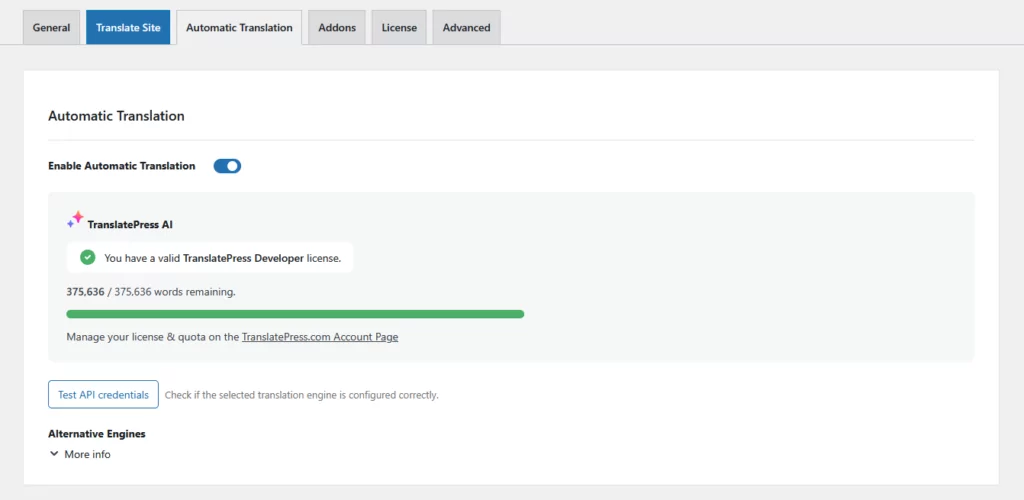
And also take a look at the tool’s frontend editor used for manual editing:
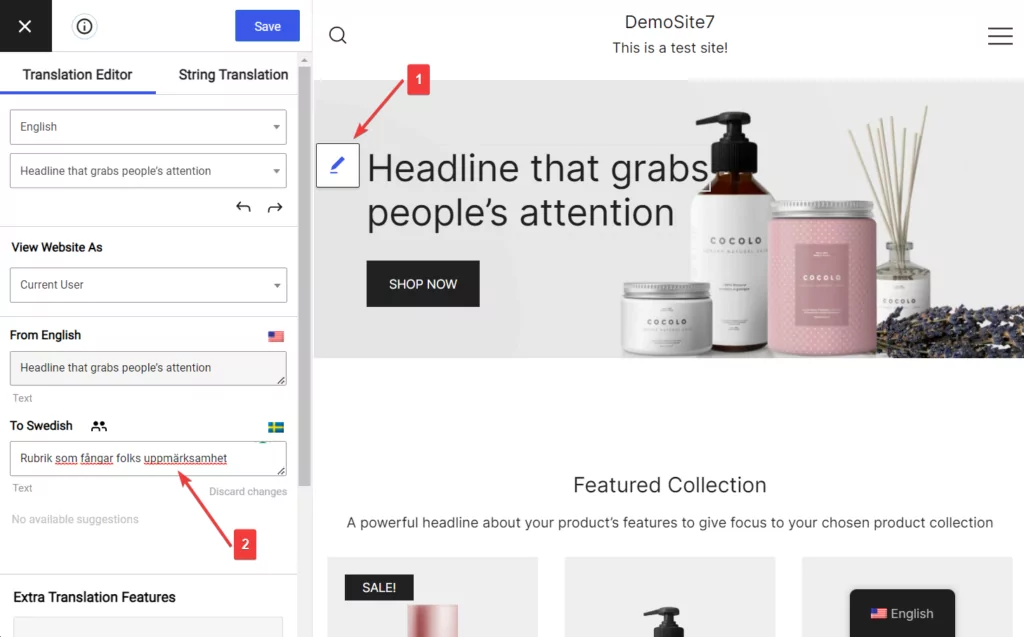
To learn more about translation tools for different types of content, take a look at the following guide: best website translation tools and best AI translation tools.
As for hiring professional translators, the following guides will be helpful: ultimate guide on translation outsourcing, best translation agencies, and best marketplaces to hire freelance translators.
5. Implementing Marketing Translations
Having identified target markets, assessed available resources, defined key focus areas for translation, and made crucial decisions on resourcing and translation methods, the next step is to craft a detailed execution plan for the translation process.
Here are a few pointers on what to include in the execution plan:
- Establish measurable goals for the marketing translation initiative, such as increased website traffic, higher engagement rates, improved conversion metrics, etc
- Map out a timeline with specific milestones for each stage of the translation process
- Allocate resources efficiently by setting a budget that accounts for potential costs
- Clearly define tasks for team members or external partners involved in the translation process
- Establish a review process to ensure accuracy, consistency, and cultural relevance in translated content
- Also, monitor performance and refine strategies based on performance data (more on this in the next section)
6. Monitor Performance

Continuous monitoring of performance metrics is essential as it allows you to gauge the effectiveness of marketing translations.
Some of the tools that you can use for monitoring performance are as follows:
- Google Search Console and Google Analytics provide valuable insights into website traffic, ranking queries, user behavior, and conversion rates for each translated version of the site
- Hotjar offers heatmaps, session recordings, and user feedback to understand how visitors interact with translated pages
- SEMrush and Ahref enable tracking of keyword performance, SEO rankings, and traffic trends for translated content
- Crowdin is a localization management platform that streamlines the translation process, facilitates collaboration among teams, and offers analytics to monitor progress
- Brandwatch offers social media monitoring and analysis tools to track brand mentions, engagement levels, and audience sentiment across different languages
- SurveyMonkey enables the creation of multilingual surveys to gather feedback from customers across the globe
You can use the data from these tools to gain actionable insights, optimize your translation efforts, and refine future strategies for optimal results.
7. Iterate & Improve
Iteration allows businesses to adapt to changing market dynamics, and customer preferences. So it’s important to iterate your marketing translation strategies based on data insight from tools used to monitor the performance of your translated content.
We encourage you to identify the most impactful tactics that helped drive significant growth in your business and double down on them in the future.
Moving forward, it’s essential to not only replicate successful tactics but also experiment with new approaches, like testing different messaging strategies, conducting A/B testing on website designs, exploring emerging digital marketing channels, etc to adapt to evolving consumer behaviors.
Conclusion
Marketing translation is the process of translating all your marketing content (like social media posts, websites, email campaigns, advertising content, etc) into one or more languages.
Implementing marketing translations can help grow your website rapidly and by many folds.
To implement marketing translations for your business, you need to carry out the following steps:
- Access market needs
- Access your existing business resources
- Decide which materials to translate
- Choose between translation tools, and professional translators, or both
- Start implementing the translation process
- Monitor performance
- Iterate and improve your strategy
That’s it for this one folks. If you have any questions about marketing translation, let us know in the comment section below.

